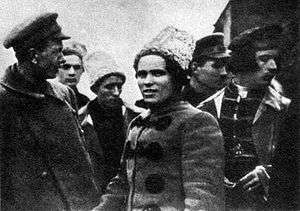Nabat
The Nabat Confederation of Anarchist Organizations,[1] better known simply as Nabat (Набат), was an anarchist organization that came to prominence in Ukraine during the years 1918 to 1920. The area where it held the most influence is sometimes referred to as Makhnovia, though Nabat had branches in all of the major cities in southern Ukraine.[2] "Nabat" is a Russian/Ukrainian word meaning tocsin, or an alarm bell toll. The group published a newspaper by the same name.
Background
In 1917 the February Revolution led to the abdication of the Russian Emperor, Tsar Nicholas II (March 1917). The collapse of a central government and ruling power in Petrograd led to the formation of a vast number of new groups and organizations which attempted to fill the power-vacuum. As the Tsarist government ceased to exist, a committee of Duma members swiftly created the Russian Provisional Government. The Provisional Government almost immediately found itself sharing power with a new assembly, the Petrograd Soviet.
On April 16, 1917, Vladimir Lenin returned to Russia from exile from Europe and added a new element to the situation. As the leader of the Bolsheviks, Lenin held an important position in Russia. The Bolsheviks began to struggle for power with other factions, including the Provisional Government, liberals, royalists, democratic socialists, and Mensheviks. As the months went by, the Bolsheviks continued to gain in influence.
In early November 1917 the Bolsheviks attempted to seize complete control of state power with the October revolution, launching an armed insurrection in Petrograd (Saint Petersburg). Fighting between the Bolsheviks, Mensheviks and other parties broke out. As Lenin tried to establish a one-party dominant system, Russia dissolved into an internecine civil war. Many newly formed anarchist organizations soon found themselves in hostile territory.[3]
Formation

As the new Russian government became increasingly hostile, many anarchists decided to leave Russia. Most of these anarchists decided to move to Ukraine because it provided an environment where they could enjoy greater freedom and put their ideas into practice. The anarchists of Moscow and Petrograd, facing suppression from the Bolsheviks, fled to Ukraine, where fifteen years previously their movement had been fostered.[1] By the fall of 1918 the Nabat Confederation of Anarchist Organizations had established its headquarters in Kharkiv, Ukraine.[5]
Nabat first came together in the autumn of 1918. As the founding members began to seek out people willing to fight for their cause, they looked to the guerrilla band led by Nestor Makhno. At the time, Makhno was the leader of the Insurgent Army of Ukraine.[5] Since Makhno already had a significant number of followers, Nabat was quickly able to gain a significant following. Nabat utilized the military force of Makhno and his army to spread their ideas using leaflets, newspapers and pamphlets. After a short period of time, Nabat had established branches in almost all of the major cities in southern Ukraine.[2]
Nabat had their first General Assembly on November 12–16, 1918. The stated purpose of the assembly was to unite the various anarchist groups in Ukraine under a unified platform to take advantage of the opportunities for societal reform offered by the ongoing Russian Civil War. The decisions made at the Assembly embraced the issues that dealt with involving anarchists in the ideological effort and affirming the need to fight against the "reactionary" forces that were fighting the civil war in the Ukraine.[6] At the Assembly, Volin was tasked with creating a "declaration of principles" that would be agreeable to all of the major schools of anarchism.[7]
The Revolutionary Experience
During the actions of the civil war, the Bolsheviks found it expedient to create an alliance with Nabat and Nestor Makhno because the Bolsheviks did not have a significant influence in Ukraine.[8] Nabat was in fact so popular that in October 1920, a delegation of the Red Army proposed to the General Assembly that they arrest Lenin and the other Bolshevik party leaders. Nabat refused the proposal on ideological grounds, since anarchists do not desire arbitrary power.[4] Despite being allied with the Soviets against the counterrevolutionary White army, Nabat severely denounced the Bolshevik regime as being authoritarian. The Bolsheviks tolerated the anarchist groups during the actions of the civil war, but quickly turned against them as soon as the threat from the White Army was taken care of and Bolshevik power consolidated. Anarchists groups, specifically Nabat, were caricaturized as being collections of brigands, allowing atrocities committed by Makhno's army because Makhno had claimed to be a great Bakunist.[9]
Organization
Nabat had a rigid and disciplined organizational structure. The purpose of this organization and disciple was to make Nabat a healthy syndicate and rise above the differences of opinion of the various schools of thought of anarchism. It was organized by federal principles, with regional components that were answerable to each other about decisions made during the general Assemblies, even when such decisions were passed by a simple majority. The Secretariat, a small leading body, oversaw the workings of Nabat. The Secretariat was seen as “technically executive” but had rather expansive duties, including guiding the Confederation ideologically, managing the monies of Nabat, publishing the newspaper and other propaganda activities, and controlling what militants the Confederation had.[8] The organization was described by Volin as "union, on a basis of federalism with some of the elements of a natural, free, and technical centralization, which is to say...fusion between fraternal and free discipline and collective responsibility."[8]
Nabat made full use of its federal nature and the evolving experience by holding several congresses of the General Assembly, attempting to hold one approximately every six months. Their main goals were to develop a coherent and universally agreed upon platform with which all of their constituent members would agree. Tactical matters that had to be addressed immediately at the Congresses were large topics. These extensive topics prevented the platform from becoming mature and formally adopted, and the experience was changing daily.[8]
Volin
Volin was a prolific writer and anarchist intellectual who played an important part in the organization and leadership of Nabat. He was one of the founders of Nabat along with being an editor of the newspaper that was published by the organization. Volin was considered to be a guiding spirit of the entire movement, and he was perpetually organizing, philosophizing, and publishing on behalf of the central body of Nabat in Kharkiv.[7] Volin was charged with writing a platform that could be agreeable to all the major branches of anarchism, most importantly anarcho-syndicalism, anarcho-collectivism/communism, and anarcho-individualism. The uniform platform for Nabat was never truly decided upon, but Volin used what he had written and the inspiration from Nabat to create his Anarchist Synthesis for which he became famous (or infamous) among anarchists. Several times during his work for Nabat, Volin was arrested: once in Autumn of 1919, again almost a year later, and finally on December 24, 1920, on the eve of a pan-Russian anarchist conference that Nabat and Volin were working to organize.[6]
Decline
It was at the end of 1920 that Nabat met its downfall. The Soviet government had established its control over the nation and no longer needed the cooperation of the anarchists, which had become enemies to be eliminated if they didn’t agree to carry out Soviet ideologies. The Bolsheviks were concerned about a rival group having political power and popularity. The Bolshevik party sent soldiers to Ukraine to overthrow Makhno and Nabat. Just three months before Volin’s arrest, Makhno’s army was defeated by the Red Army, and all of the Nabat members who were serving with him were arrested.[5]
The downfall of Makhno marked the beginning of the end for Russian anarchism. During the December 24th arrest, many other Nabat members were arrested by the Cheka along with Volin, including most of Nabat's Secretariat.[7] It was this defeat by the Bolsheviks, along with the inability of Nabat to mobilize the peasantry of Ukraine against the Red Army that caused Nabat to decline and eventually to fall.[5]
As the year of 1921 played out, other prominent anarchists within Ukraine were arrested and killed without trial. The environment of fear created by the Bolshevik party caused many surviving prominent anarchists to flee the country for a safer environment outside of Soviet control.[2]
See also
- Anarchism in Ukraine
- Platformism
- Revolutionary Insurrectionary Army of Ukraine
- Olga Taratuta
- Volin
- Synthesis anarchism
References
- Avrich, Paul (2006). The Russian Anarchists. Stirling: AK Press. p. 204. ISBN 1-904859-48-8.
- Avrich, Paul (July 1968). "Russian Anarchism and the Civil War". The Russian Review: 296–306.
- Thompson, John (2009). Russia and the Soviet Union. Westview Press. ISBN 0-669-28291-X.
- Skirda, Alexandre (2004). Nestor Makhno: Anarchy's Cossack. Paul Sharkey. AK Press. ISBN 1-902593-68-5.
- Hemmer, Jeff (2005). What was the Role of the Anarchists in the Russian Revolution? (PDF). Archived from the original on 2010-07-05.CS1 maint: BOT: original-url status unknown (link)
- Guérin, Daniel (2005). No Gods, No Masters: An Anthology of Anarchism. Paul Sharkey. AK Press.
- Avrich, Paul (1990). Anarchist Portraits. Princeton University Press. ISBN 0-691-04753-7.
- Skirda, Alexandre (2002). Facing the Enemy: A History of Anarchist Organization from Proudhon to May 1968. Paul Sharkey. AK Press. ISBN 1-902593-19-7.
- Goodwin, James (2007). "Russian Anarchism and the Bolshevization of Bakunin in the Early Soviet Period". Kritika: 533–560.
